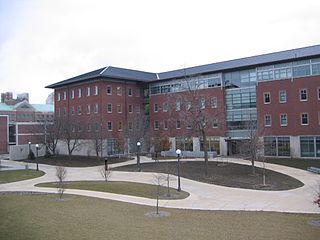
The National Center for Supercomputing Applications (NCSA) is a state-federal partnership to develop and deploy national-scale cyberinfrastructure that advances research, science and engineering based in the United States. NCSA operates as a unit of the University of Illinois Urbana-Champaign, and provides high-performance computing resources to researchers across the country. Support for NCSA comes from the National Science Foundation, the state of Illinois, the University of Illinois, business and industry partners, and other federal agencies.

The National Science Foundation (NSF) is an independent agency of the United States government that supports fundamental research and education in all the non-medical fields of science and engineering. Its medical counterpart is the National Institutes of Health. With an annual budget of about $8.3 billion, the NSF funds approximately 25% of all federally supported basic research conducted by the United States' colleges and universities. In some fields, such as mathematics, computer science, economics, and the social sciences, the NSF is the major source of federal backing.
The National Nanotechnology Initiative (NNI) is a research and development initiative which provides a framework to coordinate nanoscale research and resources among United States federal government agencies and departments.
The NSF Engineering Research Center for Wireless Integrated Microsystems was formed in 2000 in Michigan — through the collaboration of the University of Michigan (UM), Michigan State University (MSU), and Michigan Technological University.
Claire F. Gmachl is the Eugene Higgins Professor of Electrical Engineering at Princeton University. She is best known for her work in the development of quantum cascade lasers.
The University of Virginia School of Engineering and Applied Science (SEAS), established in 1836, is the oldest engineering school in the American South and the fourth oldest in the United States. SEAS is one of 12 schools and colleges at the University of Virginia.
William Joseph Kaiser is a professor and former department chair of Electrical Engineering at the University of California, Los Angeles (UCLA). He is a winner of 2007 Gold Shield Prize and has been a Fellow of American Vacuum Society since 1994. He is the director of Actuated Sensing & Coordinated Embedded Networked Technologies research group at UCLA and co-director of UCLA Wireless Health Institute.
Materials Research Science and Engineering Centers (MRSECs) are university based research centers supported by the MRSEC Program of the Division of Materials Research at the National Science Foundation (NSF). The centers support interdisciplinary and multidisciplinary research of fundamental and technological importance and integrate research with education. MRSECs require outstanding research quality, intellectual breadth, support for research infrastructure, and education outreach. MRSECs facilitate active collaborations between academic institutions, national laboratories, and industry, as well international collaborations.
Smart lighting is a lighting technology designed for energy efficiency, convenience and security. This may include high efficiency fixtures and automated controls that make adjustments based on conditions such as occupancy or daylight availability. Lighting is the deliberate application of light to achieve some aesthetic or practical effect. It includes task lighting, accent lighting, and general lighting.
Princeton University School of Engineering and Applied Science is located in Princeton, New Jersey, United States. A school within Princeton University, which is one of the eight universities of the Ivy League, it provides undergraduate and graduate instruction in six departments: chemical and biological engineering, civil and environmental engineering, computer science, electrical engineering, mechanical and aerospace engineering, and operations research and financial engineering. It has more than 1,400 undergraduates, 620 graduate students and 147 faculty members in its six departments.
Engineering Research Centers (ERC) are university-led institutions developed through the National Science Foundation (NSF) Directorate of Engineering. While ERCs are initially funded by the NSF, they are expected to be self-sustaining within 10 years of being founded. The Engineering Research Centers program was originally developed in 1984 with the mission of removing disparity between academic and industrial engineering applications. In this way, engineering students would, theoretically, be better prepared to enter the engineering workforce. As a result, the United States would gain a competitive advantage over other countries. There have been three generations of Engineering Research Centers. Each of these generations has been specifically designed to meet the dynamic engineering demands of the United States. Due to the limited amount of funding available for ERCs, the program is competitive; out of 143 proposals submitted in 2008, only 5 were awarded centers. Commercialization of academic research is one of the primary goals of NSF ERCs.

Rashid Bashir is Dean of The Grainger College of Engineering, Grainger Distinguished Chair in Engineering and Professor of Bioengineering, at the University of Illinois at Urbana-Champaign. He was the Executive Associate Dean and Chief Diversity Officer at the Carle-Illinois College of Medicine at UIUC. Previously, he was the Abel Bliss Professor of Engineering, Head of Department of Bioengineering, Director of the Micro and Nanotechnology Laboratory, and Co-Director of the campus-wide Center for Nanoscale Science and Technology, a "collaboratory" aimed at facilitating center grants and large initiatives around campus in the area of nanotechnology. Prior to joining UIUC, he was at Purdue University from 1998–2007 with faculty appointments in Electrical and Computer Engineering, and Bioengineering. From 1992 to 1998 he worked at National Semiconductor Corporation in Santa Clara, CA as Sr. Engineering Manager. He graduated with a PhD in Electrical Engineering from Purdue University in 1992. He has authored or co-authored over 240 journal papers, over 200 conference papers and conference abstracts, and over 120 invited talks, and has been granted 50 patents. He is an NSF Faculty Early Career Award winner and the 2012 IEEE EMBS Technical Achievement Award. He received the Pritzker Lecture Award from BMES in 2018. He is a fellow of IEEE, AIMBE, AAAS, BMES, RSC, APS, and NAI.

The Center for Biofilm Engineering (CBE) is an interdisciplinary research, education, and technology transfer institution located on the central campus of Montana State University in Bozeman, Montana. The center was founded in April 1990 as the Center for Interfacial Microbial Process Engineering with a grant from the Engineering Research Centers (ERC) program of the National Science Foundation (NSF). The CBE integrates faculty from multiple university departments to lead multidisciplinary research teams—including graduate and undergraduate students—to advance fundamental biofilm knowledge, develop beneficial uses for microbial biofilms, and find solutions to industrially relevant biofilm problems. The center tackles biofilm issues including chronic wounds, bioremediation, and microbial corrosion through cross-disciplinary research and education among engineers, microbiologists and industry.

Omowunmi "Wunmi" A. Sadik is a Nigerian professor, chemist, and inventor working at Binghamton University. She has developed microelectrode biosensors for detection of drugs and explosives and is working on the development of technologies for recycling metal ions from waste, for use in environmental and industrial applications. In 2012, Sadik co-founded the non-profit Sustainable Nanotechnology Organization.

Gasera Ltd. is a Finnish high-tech company focused on the analysis of gases, liquids and solid materials. The main focus of Gasera is measuring harmful air pollutants in order to protect humans and the environment. Other applications include e.g. greenhouse gas monitoring, automotive and ship emissions monitoring, dissolved gas analysis in transformer oil, CWA and TIC detection, material identification and food production and safety.
John X. J. Zhang is a professor at Thayer School of Engineering of Dartmouth College, and an investigator in the Dartmouth-Hitchcock Medical Center. Before joining Dartmouth, he was an associate professor with tenure in the Department of Biomedical Engineering at the University of Texas of Austin. He received his Ph.D. in electrical engineering from Stanford University, California in 2004, and was a research scientist in systems biology at the Massachusetts Institute of Technology (MIT) before joining the faculty at UT Austin in 2005. Zhang is a Fellow of the American Institute for Medical and Biological Engineering (AIMBE), and a recipient of the 2016 NIH Director's Transformative Research Award.
Deborah J. Jackson is an American physicist and Program Manager at the National Science Foundation, and a Fellow of the National Society of Black Physicists. She was the first African American woman to receive a Ph.D in Physics from Stanford University. She is an expert on "electromagnetic phenomena" with a research and development career that spans the full range of the electromagnetic spectrum from materials studies using hard x-ray wavelengths, to nonlinear optics and spectroscopy in the near-infrared, to the fielding of radio frequency instrumentation on deep space missions such as Cassini and Mars Observer.

Dr. Erick Christopher Jones Sr. is an Industrial Engineer and Professor in the Department of Industrial, Manufacturing, and Systems Engineering at the University of Texas at Arlington. He is considered an expert in the Radio-Frequency Identification (RFID), Quality Engineering, and Lean Six Sigma. He is the George and Elizabeth Pickett Endowed Professor, as well as Associate Dean for Graduate Studies in the College of Engineering at the University of Texas at Arlington (UTA). Jones joined UTA in 2010 after eight years at the University of Nebraska – Lincoln, where he rose to the rank of Associate Professor with tenure. He previously served as the Deputy Director of the UT Arlington's homeland security focused University Center Security Advances via Applied Nanotechnology (SAVANT) Center and he serves as the current Director of the Radio Frequency & Auto Identification (RAID) labs at UTA. Dr. Jones was the Program Director of The National Science Foundation's (NSF) Engineering Research Centers. He is currently Chair of the Supply Chain Technology Committee of International Supply Chain Education Alliance's (ISCEA) International Standards Board (IISB) and Editor in Chief of the International Supply Chain Technology Journal (ISCTJ).

The Princeton University Department of Chemistry is an academic department at Princeton University. Founded in 1795, it is one of the oldest departments of chemistry in the country and is consistently funded by grants from the National Science Foundation and the National Institutes of Health. In 2010, the department moved to its new location, the Frick Chemistry Laboratory. The department oversees the undergraduate, graduate, and post-doctoral programs in chemistry, as well as a number of research centers and initiatives at the university.

Antonio Bicchi is an Italian scientist interested in robotics and intelligent machines. He is professor at the University of Pisa and Senior Researcher at Istituto Italiano di Tecnologia in Genoa. He is an Adjunct Professor at the School of Biological and Health Systems Engineering of Arizona State University in Tempe, Arizona, USA. He is a Fellow of IEEE since 2005, and received the IEEE Saridis Leadership Award and the “Ordine del Cherubino” from University of Pisa in 2019.









